文章
Dummer. ゛☀
2017年09月30日

What comes to mind when one first thinks about “the Lily of the Valley” is a delicate flower that is symbolic of Easter and Weddings. It grows 15 to 30 cm tall, with only one or two leafs, and flowering stems, which have two leaves and 5 to 15 bell-shaped white flowers. The Lily of the Valley grows in the spring of the year and comes in three varieties from China and Japan, Eurasia, and the USA. Sadly, it is a poisonous woodland flowering plant that grows predominately in cooler temperatures in the Northern Hemisphere of Asia and Europe.
The Lily of the Valley is also known as Our Lady’s Tears or Mary’s Tears from Christian legends, which came about from Mary’s weeping when Jesus was being crucified. Another legend of the flower comes from the tears that Eve shed when she was expelled from the Garden of Eden with Adam. Lastly, the last legend was that of Saint Leonard of Noblac during his battles with a dragon.
It should be of no surprise that “the Lily of the Valley” is referred to in the Bible because it is very much a part of Christ and is reflected upon as a rose. As a symbol of humility “the Lily of the Valley” is a sign of Christ’s second coming, along with being a power for men to envision a better world. Although, “the Lily of the Valley” and “the Easter Lily” are often confused, they are both white and stand for humility and purity within the Christian religion. The Lily of the Valley is mentioned in the Bible 15 times and 8 of those times are in the book of the Song of Solomon in the Old Testament.
According to the Bible, the Lily grows in valleys, fields, gardens, and even among thorns. It is a sweet, fragrant flower that relates to the sweetness of Jesus’ ministry especially when He gave Himself for our transgressions. The Lily is also connected to motherhood, poetry, historical traditions and mythology. Then when one thinks about the white petals of the flower, they are reminded of Mary’s virgin body and her glowing soul.
In German mythology the flower is linked to the virgin goddess of spring Ostara and symbolizes life to Pagans. Additionally, the blooming of the lily refers to the feast of Ostara. Once again, the sweet smell and whiteness of the flower remind one of humility and purity of its patron goddess.
The Lily of the Valley is also known as May Lily, May Bells, Lily Constancy, Ladder-to-Heaven, Male Lily, and Muguet. Its scientific name Majalis or Maialis means “belonging to May” and is under the dominion of Mercury astrologically. Lastly, the Lily of the Valley signifies the return of happiness and perhaps this is something that should be considered a lot more in today’s society as it is more and more difficult to find peace.

The Lily of the Valley is also known as Our Lady’s Tears or Mary’s Tears from Christian legends, which came about from Mary’s weeping when Jesus was being crucified. Another legend of the flower comes from the tears that Eve shed when she was expelled from the Garden of Eden with Adam. Lastly, the last legend was that of Saint Leonard of Noblac during his battles with a dragon.

It should be of no surprise that “the Lily of the Valley” is referred to in the Bible because it is very much a part of Christ and is reflected upon as a rose. As a symbol of humility “the Lily of the Valley” is a sign of Christ’s second coming, along with being a power for men to envision a better world. Although, “the Lily of the Valley” and “the Easter Lily” are often confused, they are both white and stand for humility and purity within the Christian religion. The Lily of the Valley is mentioned in the Bible 15 times and 8 of those times are in the book of the Song of Solomon in the Old Testament.

According to the Bible, the Lily grows in valleys, fields, gardens, and even among thorns. It is a sweet, fragrant flower that relates to the sweetness of Jesus’ ministry especially when He gave Himself for our transgressions. The Lily is also connected to motherhood, poetry, historical traditions and mythology. Then when one thinks about the white petals of the flower, they are reminded of Mary’s virgin body and her glowing soul.

In German mythology the flower is linked to the virgin goddess of spring Ostara and symbolizes life to Pagans. Additionally, the blooming of the lily refers to the feast of Ostara. Once again, the sweet smell and whiteness of the flower remind one of humility and purity of its patron goddess.

The Lily of the Valley is also known as May Lily, May Bells, Lily Constancy, Ladder-to-Heaven, Male Lily, and Muguet. Its scientific name Majalis or Maialis means “belonging to May” and is under the dominion of Mercury astrologically. Lastly, the Lily of the Valley signifies the return of happiness and perhaps this is something that should be considered a lot more in today’s society as it is more and more difficult to find peace.
0
0
meriunkat
2017年09月17日

My boyfriend brought me these plants that he found at CVS all sad and dry, so ill be helping them heal😄💚 not to mention i was looking for #Kalanchoetomentosa and he brought me three of em😅 also there was some propagated babies beside them, ill show you guys tomorrow😁




4
0
Heidi Liu:@meriunkat yes, i will wait till the end~~~😂
meriunkat:@Heidi Liu oh wow that it a long time😅 but we do have high hopes😁
meriunkat:@cclecombe aww thank you😆
Heidi Liu:@meriunkat i googled, some of them said it might take up to two months and the leaf is still healthy with nothing comes out. omg, hope i will see something.
cclecombe:Fingers crossed it all goes well! What a great boyfriend!
显示更多
文章
Dummer. ゛☀
2017年08月05日

BOTANICAL NAME: Aster
PLANT TYPE: Flower
SUN EXPOSURE: Full SunPart Sun
SOIL TYPE: Loamy
SOIL PH: Varies
FLOWER COLOR: PinkPurpleRedWhite
BLOOM TIME: SummerFall
SPECIAL FEATURES: Attracts Butterflies
Asters are daisy-like perennials with starry-shaped flower heads. They bring delightful color to the garden in late summer and autumn when many of your other summer blooms may be fading.
The plant’s height ranges from 8 inches to 8 feet, depending on the type. You can find an aster for almost any garden and they have many uses, such as in borders, rock gardens, or wildflower gardens. Asters also attract butterflies to your garden!
PLANTING
Asters prefer climates with cool, moist summers—especially cool night temperatures.
Select a site with full sun to partial sun.
Soil should be moist, well-drained, and average to humus-rich.
Plant asters in early to mid-spring. Fertilize soil prior to planting. (Learn more about soil amendments and preparing soil for planting.)
While the plant can be grown from seed, germination can be uneven. You can start the seeds indoors during the winter by sowing seeds in pots or flats and keeping them in the refrigerator for 4 to 6 weeks. After 4 to 6 weeks, put the seeds in a sunny spot.
Set seeds one inch deep.
Many gardeners opt for purchasing a potted plant from the nursery instead.
Space asters 1 to 3 feet apart, depending on the type.
Give plants plenty of water at planting. Add mulch after planting to keep soil cool and prevent weeds. If you’re replanting shoots, use vigorous, young shoots to ensure best growth.
CARE
Add a thin layer of compost with a 2–inch layer of mulch around the plants every spring.
If you receive less than 1 inch of rain a week, remember to water your plants regularly during the summer. However, many asters are moisture-sensitive; if your plants have too much moisture or too little moisture, they will often lose their lower foliage or not flower well. Keep an eye out for any stressed plants and try a different watering method if your plants are losing flowers.
Stake the tall varieties in order to keep them upright and remember to pinch the young shoots to encourage bushiness.
Cut asters back in winter after the foliage has died.
Divide every 2 to 3 years in the spring to maintain your plant’s vigor and flower quality.
PESTS/DISEASES
Susceptible to:
Powdery mildew
Rusts
White smut
Leaf spots
Stem cankers
Aphids
Tarsonemid mites
Slugs and snails
Nematodes
PLANT TYPE: Flower
SUN EXPOSURE: Full SunPart Sun
SOIL TYPE: Loamy
SOIL PH: Varies
FLOWER COLOR: PinkPurpleRedWhite
BLOOM TIME: SummerFall
SPECIAL FEATURES: Attracts Butterflies
Asters are daisy-like perennials with starry-shaped flower heads. They bring delightful color to the garden in late summer and autumn when many of your other summer blooms may be fading.
The plant’s height ranges from 8 inches to 8 feet, depending on the type. You can find an aster for almost any garden and they have many uses, such as in borders, rock gardens, or wildflower gardens. Asters also attract butterflies to your garden!

PLANTING
Asters prefer climates with cool, moist summers—especially cool night temperatures.
Select a site with full sun to partial sun.
Soil should be moist, well-drained, and average to humus-rich.
Plant asters in early to mid-spring. Fertilize soil prior to planting. (Learn more about soil amendments and preparing soil for planting.)
While the plant can be grown from seed, germination can be uneven. You can start the seeds indoors during the winter by sowing seeds in pots or flats and keeping them in the refrigerator for 4 to 6 weeks. After 4 to 6 weeks, put the seeds in a sunny spot.
Set seeds one inch deep.
Many gardeners opt for purchasing a potted plant from the nursery instead.
Space asters 1 to 3 feet apart, depending on the type.
Give plants plenty of water at planting. Add mulch after planting to keep soil cool and prevent weeds. If you’re replanting shoots, use vigorous, young shoots to ensure best growth.

CARE
Add a thin layer of compost with a 2–inch layer of mulch around the plants every spring.
If you receive less than 1 inch of rain a week, remember to water your plants regularly during the summer. However, many asters are moisture-sensitive; if your plants have too much moisture or too little moisture, they will often lose their lower foliage or not flower well. Keep an eye out for any stressed plants and try a different watering method if your plants are losing flowers.
Stake the tall varieties in order to keep them upright and remember to pinch the young shoots to encourage bushiness.
Cut asters back in winter after the foliage has died.
Divide every 2 to 3 years in the spring to maintain your plant’s vigor and flower quality.

PESTS/DISEASES
Susceptible to:
Powdery mildew
Rusts
White smut
Leaf spots
Stem cankers
Aphids
Tarsonemid mites
Slugs and snails
Nematodes
0
0
文章
Carol
2017年05月23日

Learn about the Feng Shui plants and how to make a Feng Shui garden in this informative article. You can also make changes in your existing garden according to the feng shui.
Start with the parts of your garden you would like to change, grow the Feng Shui plants there and apply the principles given below and see how it works.
What is Feng Shui
Feng Shui is an art of reaching harmony in life, a practice that comes from the China. It is believed that if a place (home, garden, office or anywhere) is arranged according to the Feng Shui guidelines it remains, prosperous, peaceful and harmonious.
Principles of a Feng Shui Garden
A Feng Shui garden is a garden that is arranged in 9 areas or zones. Each represents a universe, a realm of life through forms, objects and colors. The Feng Shui garden must respect nature and be in harmony with it.
The 5 Elements

In Feng Shui, there are five basic elements– Fire, Water, Metal, Earth and Wood. They maintain harmony in the world around us and influence our lives. Therefore, in the feng shui garden design, these five elements must have to be in order in their zones.
Divison
According to the Feng Shui practice, the garden (or a home) must be divided into the nine energy zones. Draw a free-flowing square similar to the shape of your garden and divide that square into 9 equal parts.
The map will begin from your garden gate, consider the direction of your gate as North and align the feng shui map (bagua) according to it. The central area or zone will be called Tai Chi (the source of energy and life). The other eight areas or zones will surround this.
Dividing Garden into Nine Feng Shui Zones

Each zone represents an area of life and you must give space to the appropriate elements there.
North
The North is the zone that represents the fame, career and the flow and mystery of life. It symbolizes the winter season. It must have to be in the front of the entrance. Its dominant element is water and its color is blue, violet, black, and other dark colors. The shape is sinuous and items to integrate here are a water feature or pond, rocks, water plants, dark foliage plants and blue flowers.
North East
The Northeast represents wisdom and knowledge. The dominating element here is the earth and its colors are yellow, orange and cream. The shape is square. Garden benches, pots, and statues can be placed here. As the Northeast direction represents the wisdom, it is the place for meditation and yoga.
North West
Northwest part symbolizes support, friendship, guidance and represents the fall season. The dominant element here is metal and the colors to be there mainly are white, gray, golden brown, and silver. Plants like jasmine, gardenia or magnolia can be planted here. Rocks, gravels, and metallic objects are best suited here.
South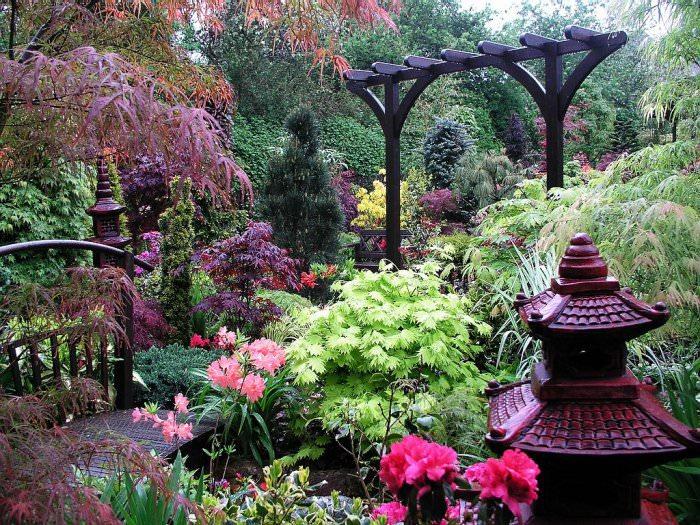
The South is the direction of success and fame and represents the summer. The dominant element here is fire and the main colors here are red, orange, purple and pink. Plants that have red or other similar colors like orange, pink, crimson, purple must be grown there. The shape of the South zone is the triangle.
South East
South East symbolizes the wealth and represents the season spring. Its dominant element is wood and its color is green and brown. You can grow here the plants that are related to this color.
South West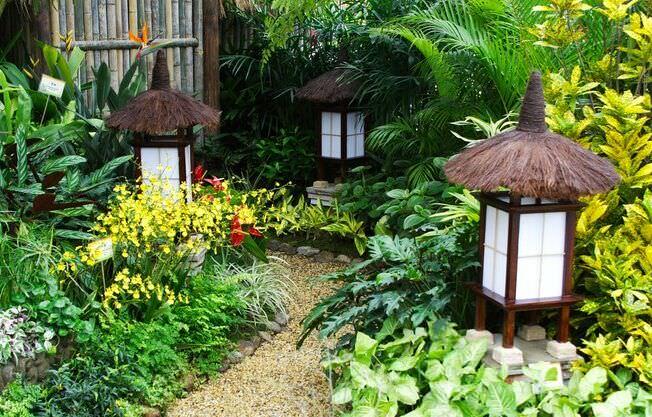
The South West is the zone that symbolizes love, pureness, and attraction between a couple. The dominant element here is Earth and the colors are to be yellow, orange, pink and other. The shape of the Southwest area is square and in this area you have to keep your garden furniture and objects in pairs to symbolize the parity.
East
This zone represents health and the season spring. Its dominant element is wood whose color is green (symbol of harmony and balance). Its shape is the rectangle. This is the area where you can grow medicinal plants, herbs, foliage plants and large trees like palms, plums, and bamboos.
West
This is the family area. Its main element is metal and its color is white (that symbolizes purity, freshness, and harmony). You can also use the gray and silver color here. The shape of the West Zone is the circle. Put some pots, chimes, rocks and wrought iron furniture. Plant shrubs here. Grow flowers of different colors together with whiter ones. Magnolia, jasmine, and lily of the valley are perfect for this area.
Central zone
Keep the central zone open and less cluttered as it is the most prominent point. This is the Tai Chi area. The key element here is earth and its color is yellow. This area represents the unity, harmony and balance. It connects all areas of the Feng Shui garden. This should be kept clean and maintained regularly.
Feng Shui Garden Design

A Feng Shui garden should not be overloaded, otherwise, Chi (energy of life) will circulate poorly. Keep the design simple.
To maintain the flow of energy, you must promote movement in the garden. Make curved paths and edgings. Invite butterflies, bees, and birds. Put feeders, grow fruit trees and flowers to attract them.
Furthermore, statues and sculptures also attract positive energy. Their size must be proportional to the garden. The large pots and urns are the holders of luck and abundance. So prefer the larger ones.
Water is an essential element in the Feng Shui garden. It is a symbol of prosperity. It takes place in the form of stream, waterfall or pond and it must be there in the appropriate zone.
The garden must be open, full of brightness and natural light. Walkways and entrances must not be blocked by any object or a tree. To bring nature, large rocks and gravels must be used.
Feng Shui Garden Plants According to Elements

The Feng Shui garden is full of positive energy and provides the perfect harmony of all the five elements. The plants you grow in your garden must be according to these elements. We offer you some examples of the plants that best represent the five elements.
A Few Popular Feng Shui PlantsBambooPeonyMaple TreePlumOrchidChrysanthemumIrisLilyLotusDaffodilMagnoliaJasmineGardeniaPine TreeCitrusGrassesElement 1. FireFeng Shui garden: Plants that represent the Fire
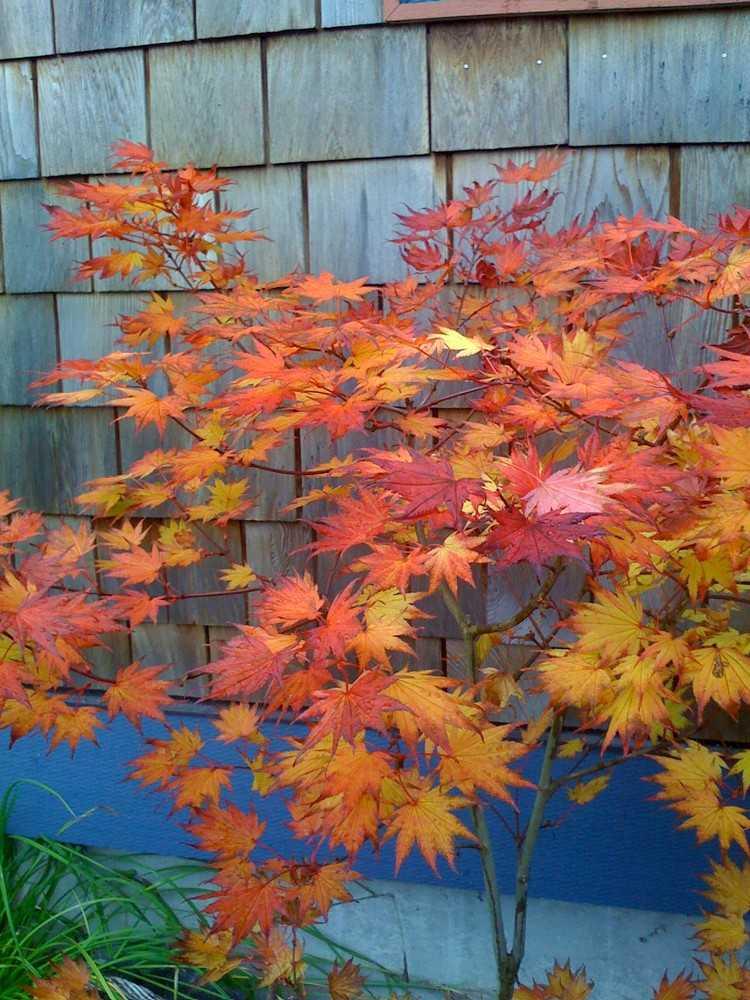
In general, plants with red bark and foliage or those with triangular or conical leaves represent the element fire. One of the most popular and the most beautiful examples of this is Japanese Maple tree (Acer palmatum).
Japanese red cedar (Cryptomeria Japonica), red camellia, boxwood shrub, holly, peonies, geraniums are other preferred Feng Shui plants that represent the fire.
Japanese Maple
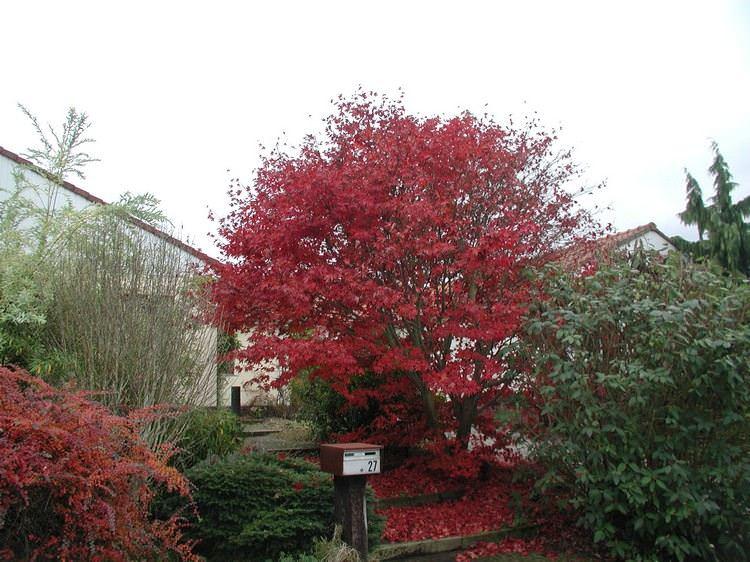
Red camellia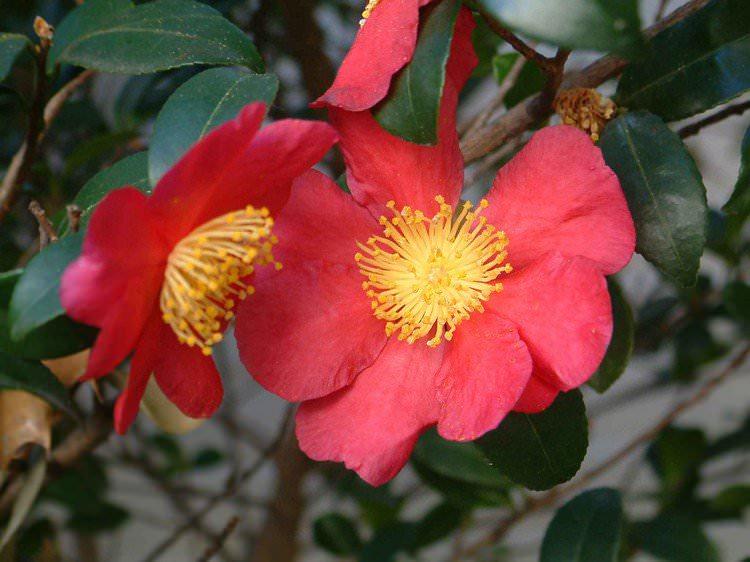
Element 2. WaterPlants that represent water element

The color of the water element is blue, violet, black. Plants of these colors represent the water element. Here are some examples: Snake’s beard, Heuchera, taro (Colocasia esculenta), sweet potato vine, iris, lily, and lotus.
Heuchera Micrantha

Sweet Potato Vine

Element 3. MetalPlants that represent the metal
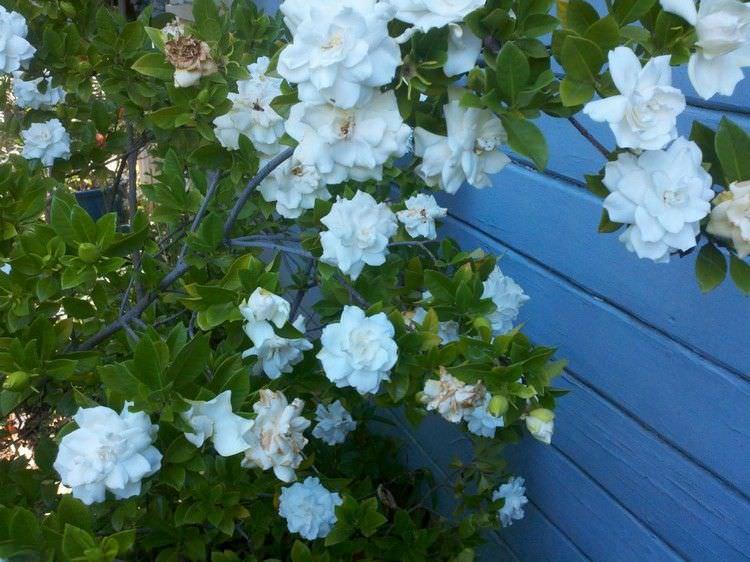
Plants that represent the metal in the Feng Shui garden are mainly those with the round or oval leaves and white flowers or of light golden brown colors. Plants like white hydrangeas, rhododendron, many species of hostas, gardenias, white mums, jasmine and dogwood tree represent the metal.
Hosta

Dogwood Tree

Hydrangea

Element 4. EarthPlants that represent the Earth
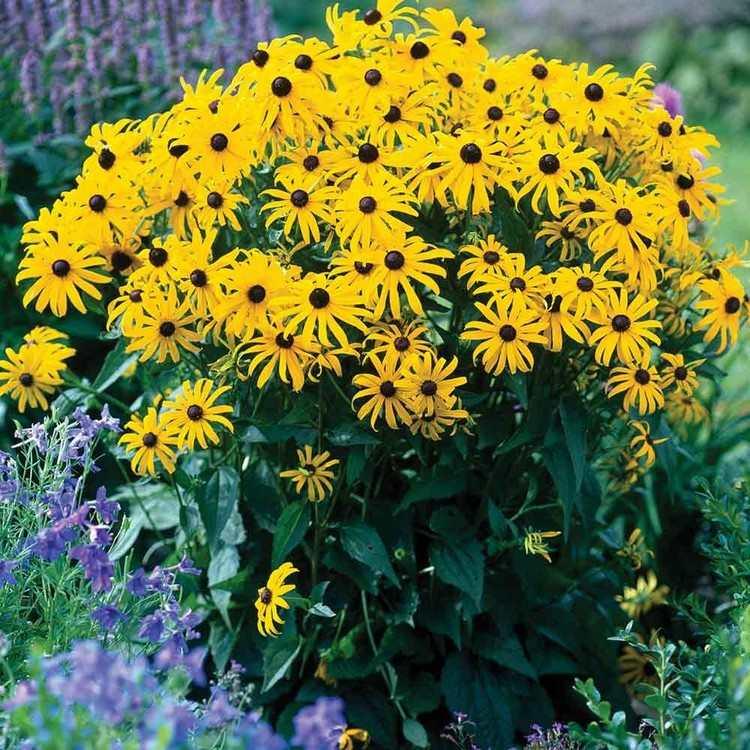
Plants with yellow flowers with similar colors or of earthy tones, those with square shaped foliage represent the Earth element in Feng Shui garden. A few of these plants that represent earth elements are Rudbeckia fulgida ‘Goldsturm’, Japanese laurel (Aucuba japonica), rhododendron, river birch (Betula nigra), Ginkgo biloba tree and grasses such as miscanthus.
Rhododendron ‘Admiral Semmes’
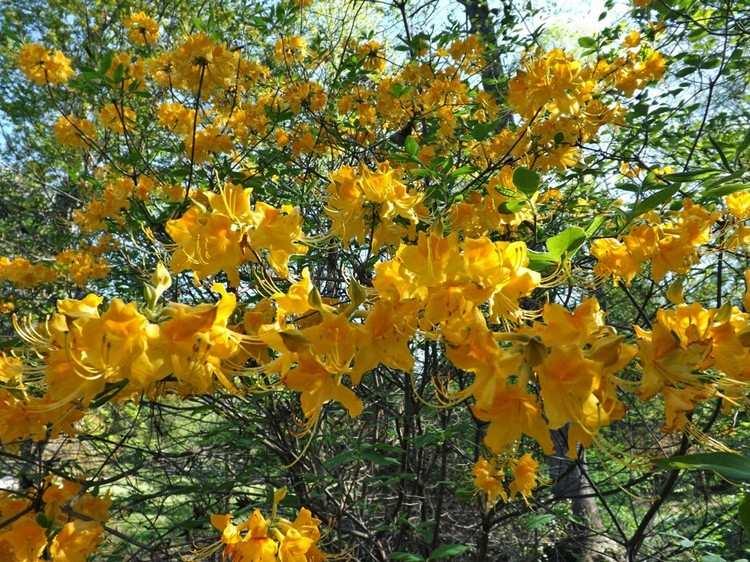
Miscanthus

Betula nigra

Aucuba japonica
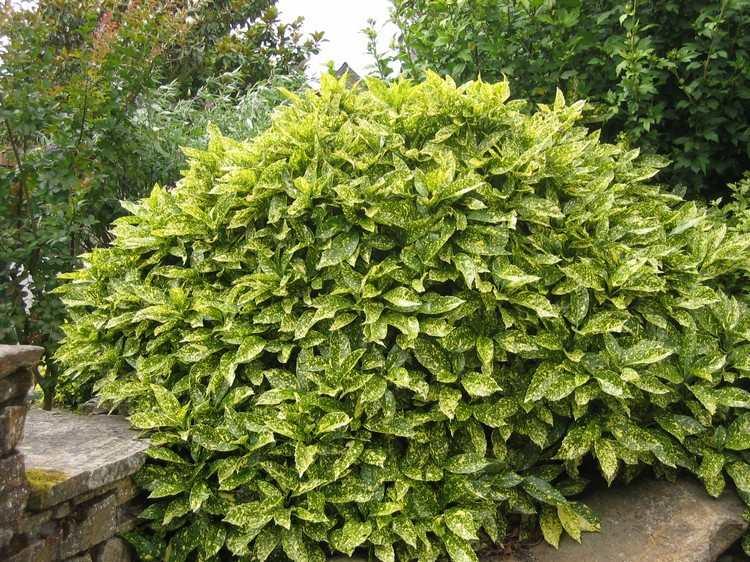
Element 5. WoodPlants that represent wood in the garden
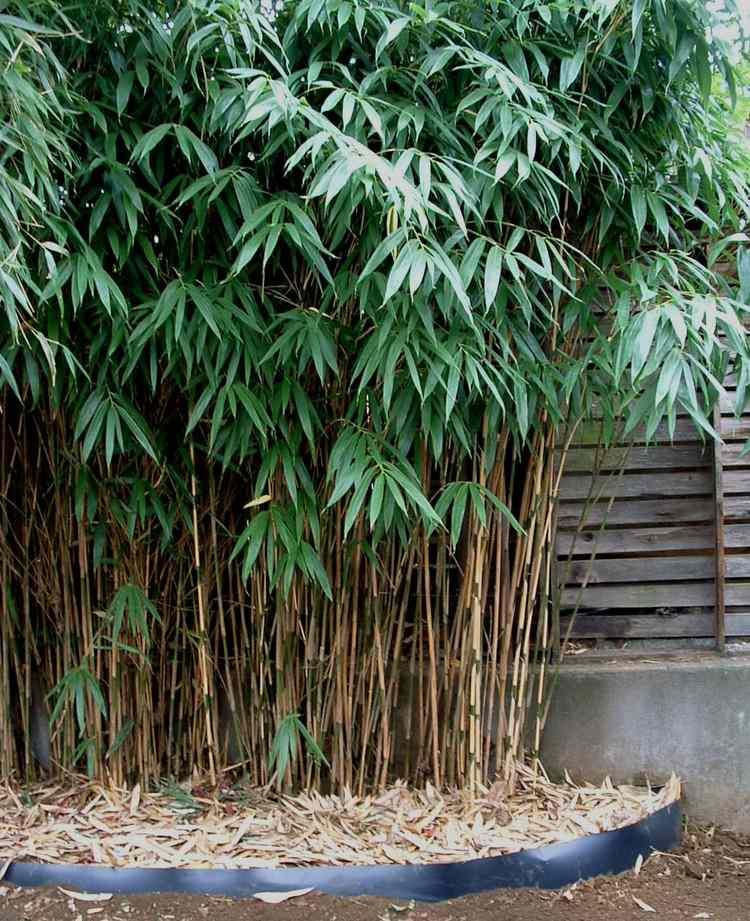
Plants with long thin stems and lush greenery such as Japanese bamboo (Pseudosasa Japonica), best represents the wood element in the Feng-shui garden. Palms, pine tree and other conifers, medicinal herbs and common lungwort (Pulmonaria Officinalis) are the plants well suited to represent the wood element in the garden.
Rosemary
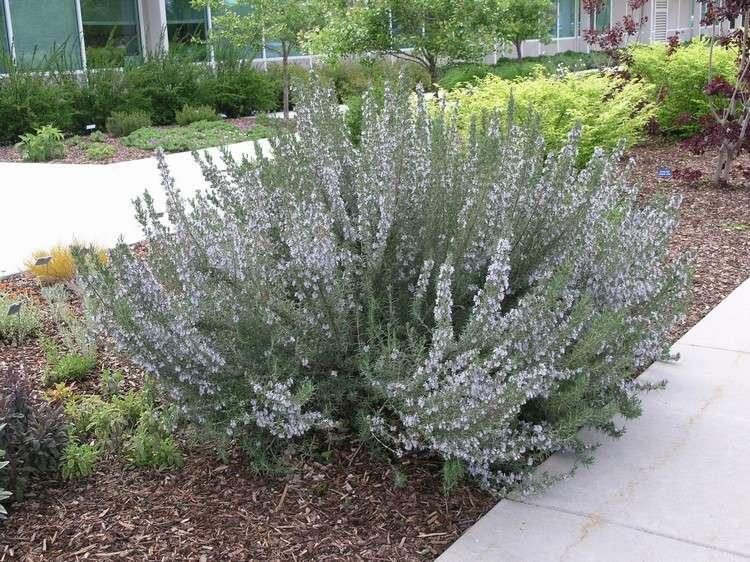
Start with the parts of your garden you would like to change, grow the Feng Shui plants there and apply the principles given below and see how it works.
What is Feng Shui
Feng Shui is an art of reaching harmony in life, a practice that comes from the China. It is believed that if a place (home, garden, office or anywhere) is arranged according to the Feng Shui guidelines it remains, prosperous, peaceful and harmonious.

Principles of a Feng Shui Garden
A Feng Shui garden is a garden that is arranged in 9 areas or zones. Each represents a universe, a realm of life through forms, objects and colors. The Feng Shui garden must respect nature and be in harmony with it.
The 5 Elements

In Feng Shui, there are five basic elements– Fire, Water, Metal, Earth and Wood. They maintain harmony in the world around us and influence our lives. Therefore, in the feng shui garden design, these five elements must have to be in order in their zones.
Divison
According to the Feng Shui practice, the garden (or a home) must be divided into the nine energy zones. Draw a free-flowing square similar to the shape of your garden and divide that square into 9 equal parts.
The map will begin from your garden gate, consider the direction of your gate as North and align the feng shui map (bagua) according to it. The central area or zone will be called Tai Chi (the source of energy and life). The other eight areas or zones will surround this.
Dividing Garden into Nine Feng Shui Zones

Each zone represents an area of life and you must give space to the appropriate elements there.
North
The North is the zone that represents the fame, career and the flow and mystery of life. It symbolizes the winter season. It must have to be in the front of the entrance. Its dominant element is water and its color is blue, violet, black, and other dark colors. The shape is sinuous and items to integrate here are a water feature or pond, rocks, water plants, dark foliage plants and blue flowers.
North East
The Northeast represents wisdom and knowledge. The dominating element here is the earth and its colors are yellow, orange and cream. The shape is square. Garden benches, pots, and statues can be placed here. As the Northeast direction represents the wisdom, it is the place for meditation and yoga.
North West
Northwest part symbolizes support, friendship, guidance and represents the fall season. The dominant element here is metal and the colors to be there mainly are white, gray, golden brown, and silver. Plants like jasmine, gardenia or magnolia can be planted here. Rocks, gravels, and metallic objects are best suited here.
South

The South is the direction of success and fame and represents the summer. The dominant element here is fire and the main colors here are red, orange, purple and pink. Plants that have red or other similar colors like orange, pink, crimson, purple must be grown there. The shape of the South zone is the triangle.
South East
South East symbolizes the wealth and represents the season spring. Its dominant element is wood and its color is green and brown. You can grow here the plants that are related to this color.
South West

The South West is the zone that symbolizes love, pureness, and attraction between a couple. The dominant element here is Earth and the colors are to be yellow, orange, pink and other. The shape of the Southwest area is square and in this area you have to keep your garden furniture and objects in pairs to symbolize the parity.
East
This zone represents health and the season spring. Its dominant element is wood whose color is green (symbol of harmony and balance). Its shape is the rectangle. This is the area where you can grow medicinal plants, herbs, foliage plants and large trees like palms, plums, and bamboos.
West
This is the family area. Its main element is metal and its color is white (that symbolizes purity, freshness, and harmony). You can also use the gray and silver color here. The shape of the West Zone is the circle. Put some pots, chimes, rocks and wrought iron furniture. Plant shrubs here. Grow flowers of different colors together with whiter ones. Magnolia, jasmine, and lily of the valley are perfect for this area.
Central zone
Keep the central zone open and less cluttered as it is the most prominent point. This is the Tai Chi area. The key element here is earth and its color is yellow. This area represents the unity, harmony and balance. It connects all areas of the Feng Shui garden. This should be kept clean and maintained regularly.
Feng Shui Garden Design

A Feng Shui garden should not be overloaded, otherwise, Chi (energy of life) will circulate poorly. Keep the design simple.
To maintain the flow of energy, you must promote movement in the garden. Make curved paths and edgings. Invite butterflies, bees, and birds. Put feeders, grow fruit trees and flowers to attract them.
Furthermore, statues and sculptures also attract positive energy. Their size must be proportional to the garden. The large pots and urns are the holders of luck and abundance. So prefer the larger ones.
Water is an essential element in the Feng Shui garden. It is a symbol of prosperity. It takes place in the form of stream, waterfall or pond and it must be there in the appropriate zone.
The garden must be open, full of brightness and natural light. Walkways and entrances must not be blocked by any object or a tree. To bring nature, large rocks and gravels must be used.
Feng Shui Garden Plants According to Elements

The Feng Shui garden is full of positive energy and provides the perfect harmony of all the five elements. The plants you grow in your garden must be according to these elements. We offer you some examples of the plants that best represent the five elements.
A Few Popular Feng Shui PlantsBambooPeonyMaple TreePlumOrchidChrysanthemumIrisLilyLotusDaffodilMagnoliaJasmineGardeniaPine TreeCitrusGrassesElement 1. FireFeng Shui garden: Plants that represent the Fire

In general, plants with red bark and foliage or those with triangular or conical leaves represent the element fire. One of the most popular and the most beautiful examples of this is Japanese Maple tree (Acer palmatum).
Japanese red cedar (Cryptomeria Japonica), red camellia, boxwood shrub, holly, peonies, geraniums are other preferred Feng Shui plants that represent the fire.
Japanese Maple

Red camellia

Element 2. WaterPlants that represent water element

The color of the water element is blue, violet, black. Plants of these colors represent the water element. Here are some examples: Snake’s beard, Heuchera, taro (Colocasia esculenta), sweet potato vine, iris, lily, and lotus.
Heuchera Micrantha

Sweet Potato Vine

Element 3. MetalPlants that represent the metal

Plants that represent the metal in the Feng Shui garden are mainly those with the round or oval leaves and white flowers or of light golden brown colors. Plants like white hydrangeas, rhododendron, many species of hostas, gardenias, white mums, jasmine and dogwood tree represent the metal.
Hosta

Dogwood Tree

Hydrangea

Element 4. EarthPlants that represent the Earth

Plants with yellow flowers with similar colors or of earthy tones, those with square shaped foliage represent the Earth element in Feng Shui garden. A few of these plants that represent earth elements are Rudbeckia fulgida ‘Goldsturm’, Japanese laurel (Aucuba japonica), rhododendron, river birch (Betula nigra), Ginkgo biloba tree and grasses such as miscanthus.
Rhododendron ‘Admiral Semmes’

Miscanthus

Betula nigra

Aucuba japonica

Element 5. WoodPlants that represent wood in the garden

Plants with long thin stems and lush greenery such as Japanese bamboo (Pseudosasa Japonica), best represents the wood element in the Feng-shui garden. Palms, pine tree and other conifers, medicinal herbs and common lungwort (Pulmonaria Officinalis) are the plants well suited to represent the wood element in the garden.
Rosemary

0
0




